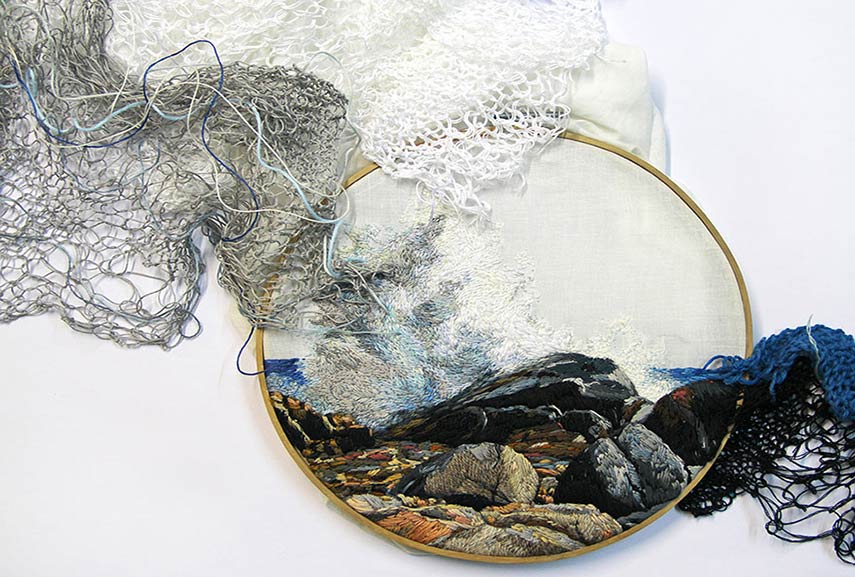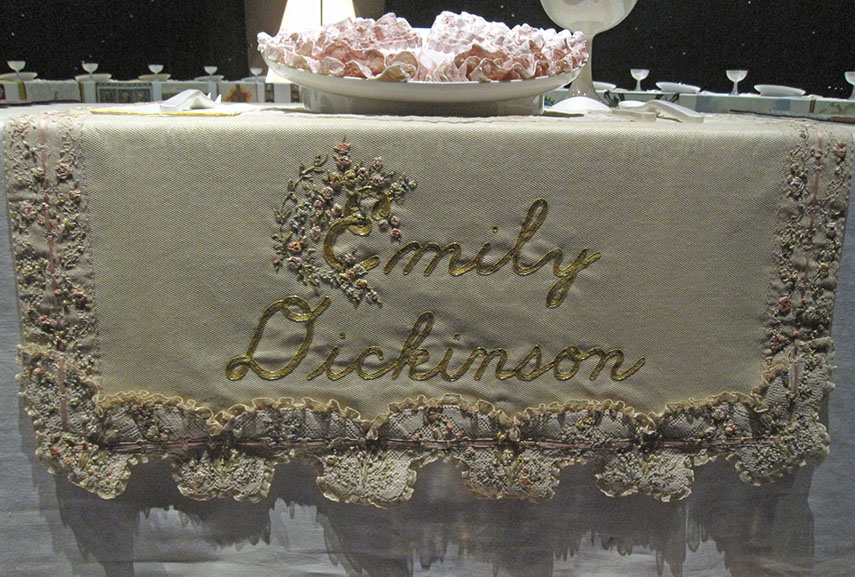Which of the Following Is Not Used in Works of Fiber Art?
Fiber art can be considered as both new and an old form of art. The use of gristly materials and the advent of the woven, knitted, printed, or in other means treated materials has long appeared in our history. Traditionally, fibrous materials emerged as functional objects but in the aftermath of the Earth War II and with further investigation into the nature of an art object, fiber art slowly became a force in its own right. During the 1950's, as various artists-craftsmen received recognition, the term cobweb art was coined to help describe their work. During this period, the contribution of craft artists , non just in fiber but in clay, ceramics, and other media inspired a number of weavers to begin binding fibers into not-functional and non-objective forms as works of art. Yet, the two decades that followed, the 60s and the 70s brought an international revolution in fiber art. With the rising of the women'due south movement, and the consequences of feminist fine art, forth with the birth of postmodernism theory, cobweb art was reinforced.

The History and the Basics of Fiber Art
Fiber art refers to fine fine art whose cloth consists of natural or synthetic fiber, and other components, such as fabric or yarn. Placing focus on the materials and the manual labor on the function of the artist, aesthetic value over utility is prioritized. Typically, fiber creatives utilize the method of weaving for the creation of their minor or large pieces. Side by side to this technique, creatives are known to practice the human activity of knotting, twining, plaiting, coiling, pleating, lashing, and interlacing.[i] Besides known as cloth fine art, fiber fine art was introduced after the war to narrate original art developments in textiles and to help define works being washed in cobweb since the 1920's. The 2 writers Larsen and Constantine were, in fact, the creators of the term which they defined every bit generic and standing for all fibrous constructions.[2] The two authors also explained the methods and the agreement of the loom every bit an expressive tool which helped fiber authors manipulate with materials and to produce their objects and pieces. Building upon the meaning and tradition of weaving, modern cobweb art needs to exist defined through the history of fabric art and the arts and crafts motion as well.

The Language of the Textile Thread – Fiber Art as an Arts Movement
During the 1950's, as authors pushed for the fresh understanding and utilize of the fiber, various creators in Europe and America experimented with the creation of works which hung on the wall or were produced as free-standing two or 3-dimensional works. Cobweb authors explored the quality of the cloth or linear elements of linen, sisal, and cotton in club to create nonobjective or figurative objects. Artist Lenore Tawney, a onetime student at the New Bauhaus affiliated with the original Bauhaus school in Federal republic of germany, was, in fact, the showtime to create three-dimensional pieces with the assistance of fiber which entered into the loonshit ofsculpture and installation fine art. Her 1961 exhibition at the Staten Island Museum is defined as the event which launched fiber art in the USA and which helped this class of inventiveness to part from the thought of being a mere craft.[3]
Yet, it was the feminist art movement and its dominant figure Judy Chicago that reintroduced textile and fiber into high fine art. Equally knitting, weaving, or needlework were typically considered as a woman'southward job of leisure or of skill, this was a major step forward. Redefining the history of art subjects and themes, feminist artists used the medium to subvert its history as 'women work' and transform it into colorful, fun, and sexually liberated works. Judy Chicago and the group of creatives which she gathered for her project Womanhouse all worked with fiber art. Chicago's piece The Dinner Party is, in fact, defined as the get-go high art piece which incorporated and celebrated needlework and fabrics as part of women's history.[4]

What Fiber Art Managed to Create
Since the 1980'due south, diverse fiber works, influenced past the postmodernist theory have become more and more conceptual. The theory inspired pieces which confronted cultural issues such as gender , issues of politics and socially predetermined roles, identity , and and so on. Soon, various fiber authors are nevertheless focused on redefining what is craft and what is art. Leaning on the tradition which saw tapestries moving away from the wall into the space of the gallery as a free-standing abstract and often geometric object, many creatives explore how fiber and its smallest pieces could be the base of operations of abstract sculpture.[5]
Within the eclectic character of contemporary fine art production, many fiber creatives dip into the sphere of habiliment fine art creating extravagant pieces of both article of clothing and of various forms.[six] Moreover, there are numerous art events and festivals which are organized to promote fiber fine art. The Fiberart International in 2016 divers its medium as "anything made of flexible, linear material and/or constructed using textile techniques such as stitching, weaving, dyeing and embroidering". The show displayed that cobweb art promotes and operates both in the form of its tradition and every bit a present object representing the digital and technological age.
From hand embroidery, tapestry and quilt product, to big-scale public art pieces or miniature handmade lace doily, fiber art is for sure a movement which continues to assistance ascertain what is art production today.

Editors' Tip: Fiber: Sculpture 1960-Present
This book is a documentation of the history of cobweb art which became popular in the 1960's. Where once the focus was on knotting, twining, and coiling thread into works that were immediately recognizable, and therefore connected to utilitarian crafts, fiber authors of the later 20th-century began to experiment with abstruse forms that were closer to sculpture than craft. Influenced by postmodernist ideas, these works are the production of experimentation with materials and technique while at the same fourth dimension confronting important cultural issues. This volume traces that evolution from the mid-twentieth century to the present. In the words of Bauhaus weaver Anni Albers, the expressive quality of fiber is essentially a "language of thread." That linguistic communication is beautifully displayed in full-color spreads and individual illustrations in this book. Scholarly essays address the feminist movement of the 1970s; the expanded use of materials in the '80s and '90s; and the more recent employment of fiber as ane more material in the creation of freestanding works.
References:
All images used for illustrative purposes only. Featured image in slider: Francoise Grossen – Inchworm. Epitome via wbur.org; Hassan Sharif - Slippers, 2016 with Gallery Isabelle van den Eynde; Romina de Novellis with Alberta Pane. Image via widewalls.ch
Source: https://www.widewalls.ch/magazine/fiber-art